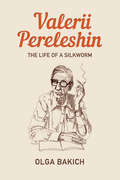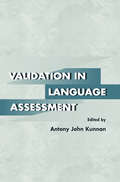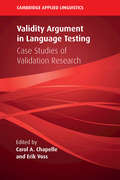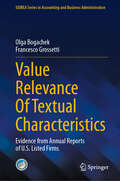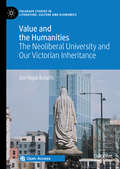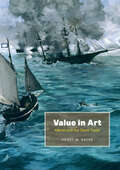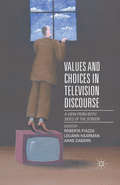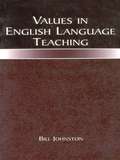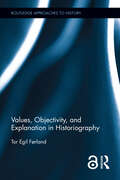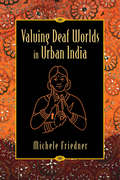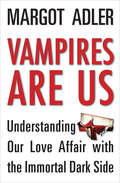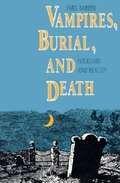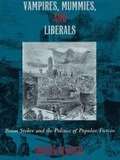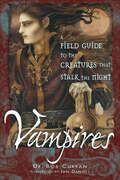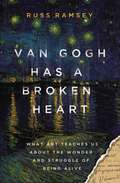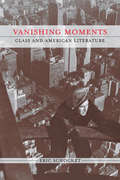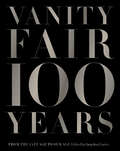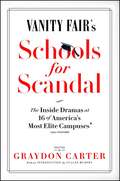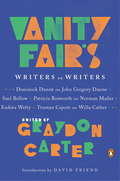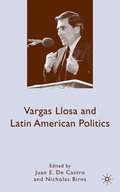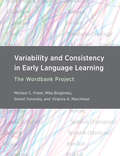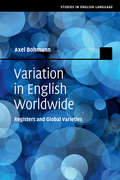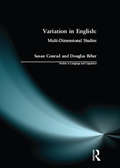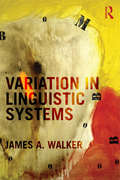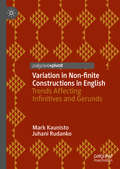- Table View
- List View
Valerii Pereleshin: The Life of a Silkworm
by Olga BakichOlga Bakich's biography of Valerii Pereleshin (1913-1992) follows the turbulent life and exquisite poetry of one of the most remarkable Russian émigrés of the twentieth century. Born in Irkutsk, Pereleshin lived for thirty years in China and for almost forty years in Brazil. Multilingual, he wrote poetry in Russian and in Portuguese and translated Chinese and Brazilian poetry into Russian and Russian and Chinese poetry into Portuguese. For many years he struggled to accept and express his own identity as a gay man within a frequently homophobic émigré community. His poems addressed his three homelands, his religious struggles, and his loves. In Valerii Pereleshin: The Life of a Silkworm, Bakich delves deep into Pereleshin's poems and letters to tell the rich life story of this underappreciated writer.
Validation in Language Assessment
by Antony John KunnanValidation in Language Assessment contributes to the variety of validation approaches and analytical and interpretive techniques only recently adopted by language assessment researchers. Featuring selected papers from the 17th Language Testing Research Colloquium, the volume presents diverse approaches with an international perspective on validation in language assessment.
Validity Argument in Language Testing: Case Studies of Validation Research (Cambridge Applied Linguistics)
by Carol A. Chapelle Erik VossLanguage tests play pivotal roles in education, research on learning, and gate-keeping decisions. The central concern for language testing professionals is how to investigate whether or not tests are appropriate for their intended purposes. This book introduces an argument-based validity framework to help with the design of research that investigates the validity of language test interpretation and use. The book presents the principal concepts and technical terms, then shows how they can be implemented successfully in practice through a variety of validation studies. It also demonstrates how argument-based validity intersects with technology in language testing research and highlights the use of validity argument for identifying research questions and interpreting the results of validation research. Use of the framework helps researchers in language testing to communicate clearly and consistently about technical issues with each other and with researchers of other types of tests.
Value Relevance Of Textual Characteristics: Evidence from Annual Reports of U.S. Listed Firms (SIDREA Series in Accounting and Business Administration)
by Francesco Grossetti Olga BogachekThis book explores the evolution of value relevance in finance and accounting. While synthesizing existing literature to provide a robust theoretical framework, it also extends the discourse by incorporating textual characteristics into the traditional model of value relevance. The authors integrate two pivotal but often disparate research domains: value relevance and linguistic analysis in accounting disclosures. This inclusion enriches our understanding of how qualitative factors, such as tone and readability in corporate disclosures, interact with quantitative measures to influence market behavior and investor decision-making. The result is a nuanced, multi-dimensional analysis that not only bridges gaps in current academic research but also offers new avenues for practical application. The book starts by laying the groundwork for the concept of value relevance, discussing its evolution in the academic literature, theoretical models, their assumptions, and limitations. It then turns the spotlight onto corporate disclosure theories, thereby illuminating the strategies and psychological factors that influence how companies report their financials and accompanying narrative discussions. The authors demonstrate how the information is strategically disclosed and received, adding another layer of complexity to the concept of value relevance. The novel contribution of this manuscript comes from the methodological approach, incorporating textual analysis techniques into a widely-accepted Ohlson value relevance model. The authors empirically integrate textual elements like tone and readability and demonstrate how they can play a significant role in how investors perceive a company. The empirical section of the book provides robust evidence to support the central thesis—that qualitative elements in financial disclosures are not merely supplementary but are indeed value-relevant. This enhances the book's applicability across both academic and practical settings. In conclusion, this book serves as a comprehensive guide for those interested in the complexities of value relevance as well as the dynamics of financial disclosures. It offers valuable insights that are both theoretically robust and empirically validated, making it a useful resource for academics, practitioners, and regulators. It enriches the academic discourse by offering new pathways for research and practical application in a world where financial information is increasingly digitized. The target audience for this book includes academics in the fields of accounting and finance, as well as practitioners and regulators who are keen on understanding the evolving dynamics of how financial information impacts the capital markets.
Value and the Humanities: The Neoliberal University and Our Victorian Inheritance (Palgrave Studies in Literature, Culture and Economics)
by Zoe Hope BulaitisTracing the shift from liberal to neoliberal education from the nineteenth century to the present day, this open access book provides a rich and previously underdeveloped narrative of value in higher education in England. Value and the Humanities draws upon historical, financial, and critical debates concerning educational and cultural policy. Rather than writing a singular defence of the humanities against economic rationalism, Zoe Hope Bulaitis constructs a nuanced map of the intersections of value in the humanities, encompassing an exploration of policy engagement, scientific discourses, fictional representation, and the humanities in public life. The book articulates a kaleidoscopic range of humanities practices which demonstrate that although recent policy encourages higher education to be entirely motivated by outcomes, fiscal targets, and the acquisition of employability skills, the humanities continue to inspire and aspire beyond these limits. This book is a historically-grounded and theoretically-informed analysis of the value of the humanities within the context of the market.
Value in Art: Manet and the Slave Trade
by Henry M. SayreArt historian Henry M. Sayre traces the origins of the term “value” in art criticism, revealing the politics that define Manet’s art. How did art critics come to speak of light and dark as, respectively, “high in value” and “low in value”? Henry M. Sayre traces the origin of this usage to one of art history’s most famous and racially charged paintings, Édouard Manet’s Olympia. Art critics once described light and dark in painting in terms of musical metaphor—higher and lower tones, notes, and scales. Sayre shows that it was Émile Zola who introduced the new “law of values” in an 1867 essay on Manet. Unpacking the intricate contexts of Zola’s essay and of several related paintings by Manet, Sayre argues that Zola’s usage of value was intentionally double coded—an economic metaphor for the political economy of slavery. In Manet’s painting, Olympia and her maid represent objects of exchange, a commentary on the French Empire’s complicity in the ongoing slave trade in the Americas. Expertly researched and argued, this bold study reveals the extraordinary weight of history and politics that Manet’s painting bears. Locating the presence of slavery at modernism’s roots, Value in Art is a surprising and necessary intervention in our understanding of art history.
Values and Choices in Television Discourse: A View from Both Sides of the Screen
by Roberta Piazza Louann Haarman Anne CabornThe high-pressured, fast-paced environment of television production leaves little time for producers to reflect on how the potentialities of texts and images will be interpreted outside of the immediate broadcast imperatives. This volume brings together the producers and analysts of television in a formal and productive way.
Values in English Language Teaching
by Bill JohnstonThis book offers a new perspective on language teaching by placing moral issues--that is, questions of values--at the core of what it is to be a teacher. The teacher-student relation is central to this view, rather than the concept of language teaching as merely a technical matter of managing students' acquisition of language. The message is that all language teaching involves an interplay of deeply held values, but in each teaching situation these values are played out in different ways. Johnston does not tell readers what to think, but only suggests what to think about. Values in English Language Teaching explores the complex and often contradictory moral landscape of the language classroom, gradually revealing how teaching is not a matter of clear-cut choices but of wrestling with dilemmas and making difficult decisions in situations often riven with conflict. It examines the underlying values that teachers hold as individuals and as members of their profession, and demonstrates how those values are played out in the real world of language classrooms. Matters addressed include connections between the moral and political dimensions in English language teaching, and between values and religious beliefs; relationship(s) between teacher identity and values; the meaning of professionalism and how it is associated with morality and values; the ways in which teacher development is a moral issue; and the marginality of English language teaching. All the examples are taken from real-life teaching situations--the complexity and messiness of these situations is always acknowledged, including both individual influences and broader social, cultural, and political forces at play in English language classrooms. By using actual situations as the starting point for analysis, Johnston offers a philosophy based in practice, and recognizes the primacy of lived experience as a basis for moral analysis. Examples come from teaching contexts around the world, including Brazil, Thailand, Poland, Japan, Central African Republic, Turkey, and Taiwan, as well as various settings in the United States. This book will change the way teachers see language classrooms--their own or those of others. It is a valuable resource for teachers of ESL and EFL and all those who work with them, especially teacher educators, researchers, and administrators.
Values, Objectivity, and Explanation in Historiography (Routledge Approaches to History #21)
by Tor Egil FørlandBringing sophisticated philosophy to bear on real-life historiography, Values, Objectivity, and Explanation in Historiography rekindles and invigorates the debate on two perennials in the theory and methodology of history. One is the tension between historians' values and the ideal—or illusion—of objective historiography. The other is historical explanation. The point of departure for the treatment of values and objectivity is an exceptionally heated debate on Cold War historiography in Denmark, involving not only historians but also the political parties, the national newspapers, and the courts. The in-depth analysis that follows concludes that historians can produce accounts that deserve the label "objective," even though their descriptions are tinged by ineluctable epistemic instability. A separate chapter dissects the postmodern notion of situated truths. The second part of the book proffers a new take on historical explanation. It is based on the notion of the ideal explanatory text, which allows for not only causal—including intentional—but also nomological, structural, and functional explanations. The approach, which can accommodate narrative explanations driven by causal plots, is ecumenical but not all-encompassing. Emergent social properties and supernatural entities are excluded from the ideal explanatory text, making scientific historiography methodologically individualistic—albeit with room for explanations at higher levels when pragmatically justified—and atheist.
Valuing Deaf Worlds in Urban India
by Michele Ilana FriednerAlthough it is commonly believed that deafness and disability limits a person in a variety of ways, Valuing Deaf Worlds in Urban India describes the two as a source of value in postcolonial India. Michele Friedner argues that the experiences of deaf people offer an important portrayal of contemporary self-making and sociality under new regimes of labor and economy in India. Friedner contends that deafness actually becomes a source of value for deaf Indians as they interact with nongovernmental organizations, with employers in the global information technology sector, and with the state. In contrast to previous political economic moments, deaf Indians increasingly depend less on the state for education and employment, and instead turn to novel and sometimes surprising spaces such as NGOs, multinational corporations, multilevel marketing businesses, and churches that attract deaf congregants. They also gravitate towards each other. Their social practices may be invisible to outsiders because neither the state nor their families have recognized Indian Sign Language as legitimate, but deaf Indians collectively learn sign language, which they use among themselves, and they also learn the importance of working within the structures of their communities to maximize their opportunities. Valuing Deaf Worlds in Urban India analyzes how diverse deaf people become oriented toward each other and disoriented from their families and other kinship networks. More broadly, this book explores how deafness, deaf sociality, and sign language relate to contemporary society.
Vampires Are Us: Understanding Our Love Affair with the Immortal Dark Side
by Margot AdlerThe author of Drawing Down the Moon offers a "literate, imaginative, and just plain fascinating&” exploration of the enduring allure of vampires (Whitley Strieber, author of The Hunger). Author and NPR correspondent Margot Adler found herself newly drawn to vampire novels while sitting vigil at her dying husband&’s bedside. Intrigued by the way this ever-evolving myth lets us contemplate mortality, she embarked on a years-long journey of reading hundreds vampire novels—from teen to adult, from gothic to modern, from detective to comic. She began to see just how each era creates the vampires it needs. Dracula, an Eastern European monster, was the perfect vehicle for 19th-century England&’s fear of outsiders and of disease seeping in through its large ports. In 1960s America, the television show Dark Shadows gave us the morally conflicted vampire struggling against his own predatory nature, who still enthralls us today. From Bram Stoker to Ann Rice; from vampire detective thrillers to lesbian vampire fiction; and from Buffy the Vampire Slayer to Twilight and True Blood, Vampires Are Us explores the issues of power, politics, morality, identity, and even the fate of the planet that show up in vampire novels today. Perhaps, Adler suggests, our blood is oil, perhaps our prey is the planet. Perhaps vampires are us.
Vampires, Burial and Death: Folklore and Reality
by Paul BarberIn this engrossing book, Paul Barber surveys centuries of folklore about vampires and offers the first scientific explanation for the origins of the vampire legends. From the tale of a sixteenth-century shoemaker from Breslau whose ghost terrorized everyone in the city, to the testimony of a doctor who presided over the exhumation and dissection of a graveyard full of Serbian vampires, his book is fascinating reading.
Vampires, Mummies and Liberals: Bram Stoker and the Politics of Popular Fiction
by David GloverNearly a hundred years after its debut in 1897, Dracula is still one of the most popular of all Gothic narratives, always in print and continually adapted for stage and screen. Paradoxically, David Glover suggests, this very success has obscured the historical conditions and authorial circumstances of the novel's production. By way of a long overdue return to the novels, short stories, essays, journalism, and correspondence of Bram Stoker, Vampires, Mummies, and Liberals reconstructs the cultural and political world that gave birth to Dracula. To bring Stoker's life into productive relationship with his writing, Glover offers a reading that locates the author within the changing commercial contours of the late-Victorian public sphere and in which the methods of critical biography are displaced by those of cultural studies.Glover's efforts reveal a writer who was more wide-ranging and politically engaged than his current reputation suggests. An Irish Protestant and nationalist, Stoker nonetheless drew his political inspiration from English liberalism at a time of impending crisis, and the tradition's contradictions and uncertainties haunt his work. At the heart of Stoker's writing Glover exposes a preoccupation with those sciences and pseudo-sciences--from physiognomy and phrenology to eugenics and sexology--that seemed to cast doubt on the liberal faith in progress. He argues that Dracula should be read as a text torn between the stances of the colonizer and the colonized, unable to accept or reject the racialized images of backwardness that dogged debates about Irish nationhood. As it tracks the phantasmatic form given to questions of character and individuality, race and production, sexuality and gender, across the body of Stoker's writing, Vampires, Mummies, and Liberals draws a fascinating portrait of an extraordinary transitional figure.Combining psychoanalysis and cultural theory with detailed historical research, this book will be of interest to scholars of Victorian and Irish fiction and to those concerned with cultural studies and popular culture.
Vampires: A Field Guide to the Creatures that Stalk the Night
by Bob CurranA guide to the origins and legends of undead mythological monsters from around the world.“Vampire!” The very word conjures up visions of ruined castles, of enigmatic, pale-skinned noblemen shrouded in dark cloaks, of slumbering beauties being bloodily ravished by supernatural, nocturnal creatures. But just how accurate is that picture? How much do we really know about these mysterious entities? Surprisingly, perhaps, almost every culture can boast of its own vampire beings, few of which correspond to the stock Hollywood image—some are not even human in form, some do not drink blood, some appear in daylight. Are you ready for such horrors as the Penangal, the screaming blood-soaked lead that drifts through the Malayan jungle seeking victims; the Jaracacca, the Brazilian stalker that hides in the clothes of its victims to drink their blood or bodily fluids; or the Aswang, the scaly demon of the Philippines, who lies among the leafy roofs of huts and drinks through its tongue? And how do we dispose of vampires? Is the simple stake through the heart—much beloved of Hollywood directors—really enough, or is there something more? And does the sight of the crucifix repel all vampires—what if the vampire is Jewish (a dibbyuk)? Vampires is a unique, lavishly illustrated work that explores the rich diversity of vampire belief and lore, ranging from countries as diverse as Japan, Sweden, and Ireland, looking at their historical origins, and setting them in their cultural context.
Van Gogh Has a Broken Heart: What Art Teaches Us About the Wonder and Struggle of Being Alive
by Russ RamseyBeyond a mere introduction to great art, Van Gogh Has a Broken Heart is about loving to learn what art has to teach us about the wonder and struggle of being alive.Did you know that:Vincent van Gogh's attempt to start an artist's colony with Paul Gauguin lasted only nine weeks, ending in his infamous "ear episode"?Pablo Picasso was a prime suspect in the disappearance of the Mona Lisa?Artemisia Gentileschi was tortured with thumbscrews to verify her testimony at her own rapist's trial?Norman Rockwell's critics said his work would never be accepted as "high art"--and he agreed?These stories--and many more--shaped the work these artists left behind. In their art are lessons common to the human experience about the wonder and struggle of being alive: dreams lost, perspectives changed, and humility derived through suffering.??In Van Gogh Has a Broken Heart, Russ Ramsey digs into these artists' stories for readers who may be new to art, as well as for lifelong students of art history, to mine the transcendent beauty and hard lessons we can take from their masterpieces and their lives. Each story from some of the history's most celebrated artists applies the beauty of the gospel in a way that speaks to the suffering and hope we all face.
Vanishing Moments: Class and American Literature
by Eric SchocketSchocket examines the image of the working class in American literature from the first appearance of industrial fiction in the 1850s to the rise and fall of proletarian literature in the 1930s. A theoretical introductory chapter is followed by five historically framed readings of groups of texts. These include the late antebellum era and America's earliest labor narratives within the context of slave labor; strikes and other labor actions in the 1880s as a collective discourse; 19th-century political culture and labor narratives; the high modernism of the 1910s; and the proletarian culture movement of the 1930s. Among the texts discussed are works by Herman Melville, Rebecca Harding Davis, William Dean Howells, Jack London, T. S. Eliot, Gertrude Stein, Muriel Rukeyser, and Langston Hughes. Schocket (1966-2006) was a professor of American literature at Hampshire College. Annotation ©2007 Book News, Inc. , Portland, OR (booknews. com)
Vanity Fair 100 Years: From the Jazz Age to Our Age
by Graydon Carter&“Page after page of stunningly rendered images. . . . go to the party that is Vanity Fair. This time, we&’re all invited.&” —The New York Times In words, photography, and illustrations, this book spans a century of personality and power, art and commerce, current events, crises, and culture both highbrow and low, as chronicled in the magazine Vanity Fair. From its inception in 1913, through the Jazz Age and the Depression, to its reincarnation in the boom-boom Reagan years, to the image-saturated Information Age, Vanity Fair has presented the modern era as it unfolded, using wit, imagination, peerless literary narrative, and bold, groundbreaking imagery from the greatest photographers, artists, and illustrators of the day. This sumptuous book takes a decade-by-decade look at the world as seen by the magazine, with stops to describe the incomparable editor Frank Crowninshield and the birth of the Jazz Age Vanity Fair, the magazine&’s controversial rebirth in 1983, and the history of the glamorous Vanity Fair Oscar Party.
Vanity Fair's Schools For Scandal: The Inside Dramas at 16 of America's Most Elite Campuses—Plus Oxford!
by Graydon CarterVanity Fair editor Graydon Carter shares a definitive, provocative collection of the magazine’s finest dispatches on the political, sexual, and administrative scandals that have swept our nation’s campuses.Vanity Fair’s Schools for Scandal, edited by Graydon Carter, with an introduction by Cullen Murphy, brings together the magazine’s finest reporting on the scandals that have swept our nation’s most elite campuses over the past twenty-five years—all in one definitive, provocative volume. The stories collected here speak to an American obsession with status and to the lengths we will go to achieve it, preserve it, or destroy it—from the enduring, shadowy influence of Yale’s secret societies to the infamous “senior salute” at St. Paul’s School; from the false accusations in the Duke lacrosse team’s infamous rape case to the (mis)reportage of a sexual assault at the University of Virginia; from a deadly extreme-sport episode at Oxford to the Keystone Kop theft of a college’s rare books to the allegations of fraud by the now-shuttered Trump University. Vanity Fair’s Schools for Scandal brings focus to the perils facing American education today and how the life of the mind, and the significance of the institutions meant to foster it, has been negatively impacted by the partisan politics of privatization, tensions over so-called political correctness, the fraught dynamic of the teacher-student relationship, and what happens when visions for a bold future collide with the desire to maintain hidebound (or venerable) traditions. With an array of Vanity Fair’s signature writers—including Buzz Bissinger, William D. Cohan, Sarah Ellison, Evgenia Peretz, Todd S. Purdum, and Sam Tanenhaus, among others—Vanity Fair’s Schools for Scandal presents a compelling if troubling account of the state of elite education today, and the evolving social, sexual, racial, and economic forces that have shaped it.
Vanity Fair's Writers on Writers
by Graydon Carter David FriendA collection of beloved authors on beloved writers, including Martin Amis on Saul Bellow, Truman Capote on Willa Cather, and Salman Rushdie on Christopher Hitchens, as featured in Vanity Fair What did Christopher Hitchens think of Dorothy Parker? How did meeting e.e. cummings change the young Susan Cheever? What does Martin Amis have to say about how Saul Bellow's love life influenced his writing? Vanity Fair has published many of the most interesting writers and thinkers of our time. Collected here for the first time are forty-one essays exploring how writers influence one another and our culture, from James Baldwin to Joan Didion to James Patterson. From the Trade Paperback edition.
Vargas Llosa and Latin American Politics
by Juan E. De Castro Nicholas BirnsMario Vargas Llosa is a heterogeneous writer whose positions have often not been consistent from novel to novel, between his fictional and nonfictional work, between his literary and political commentary, and as his political commentary has proceeded over the decades. This analysis of his work reveals his insights into socio-political matters.
Variability and Consistency in Early Language Learning: The Wordbank Project
by Michael C. Frank Mika Braginsky Daniel Yurovsky Virginia A. MarchmanA data-driven exploration of how children's language learning varies across different languages, providing both a theoretical framework and reference.The Wordbank Project examines variability and consistency in children's language learning across different languages and cultures, drawing on Wordbank, an open database with data from more than 75,000 children and twenty-nine languages or dialects. This big data approach makes the book the most comprehensive cross-linguistic analysis to date of early language learning. Moreover, its data-driven picture of which aspects of language learning are consistent across languages suggests constraints on the nature of children's language learning mechanisms. The book provides both a theoretical framework for scholars of language learning, language, and human cognition, and a resource for future research.
Variation in English Worldwide: Registers and Global Varieties (Studies in English Language)
by Axel BohmannWorld Englishes is one of the most active fields of present day linguistic research. This book provides a comprehensive overview of variation in English across the globe, by analysing a large corpus of texts from the English speaking world. The analysis draws on a larger number of individual texts and linguistic features than previous studies have done. It includes a systematic comparison of the influence of register and national variety on variation in English world-wide, and explores patterns of variation in both qualitative and quantitative terms. The results provide a testing ground for theoretical models, and highlight the importance of register in mediating linguistic differences across national varieties.
Variation in English: Multi-Dimensional Studies (Studies in Language and Linguistics)
by Douglas Biber Susan ConradStudies in Language and LinguisticsGeneral Editors- Geoffrey Leech, Department of Modern English Language, Lancaster University and Jenny Thomas, School of English and Linguistics, University of Wales, BangorBroad-ranging and authoritative, Studies in Language and Linguistics is an occasional seriesincorporating major new work in all areas of linguistics. Variation in English- Multi-Dimensional Studies provides both a comprehensive view into a relatively new technique for studying language, and a diverse, exciting collection of studies of variation in English. The first part of the book provides an explanation of multi-dimensional (MD) analysis, a research technique for studying language variation. MD is a corpus-based approach developed by Doug Biber that facilitates large-scale studies of language variation and the investigation of research questions that were previously intractable. The second part of the book contains studies that apply Biber's original MD analysis of English to new domains. These studies cover the historical evolution of English; specialized domains such as medical writing and oral proficiency testing; and dialect variation, including gender and British/American.The third part of the book contains studies that conduct new MD analyses, covering adult/child language differences, 18th century speech and writing, and discourse complexity. Readers of this book will become familiar with the analytical techniques of multi-dimensional analysis, with its applicability to a wide variety of language issues, and with the findings of important studies previously published in diverse journals as well as new studies appearing for the first time.
Variation in Linguistic Systems
by James A. WalkerTying together work on a number of languages and linguistic varieties in different locales, this book provides students and researchers with a convenient, unified overview of variationist analysis in linguistics. Variation in Linguistic Systems takes a theoretical and quantitative approach to the study of variation in language, focusing on the role of language-internal constraints on variation and the relation of linguistic variation to linguistic theory. It introduces the basic concepts of variationist linguistics and includes key discussions on language change, language contact, the different types of variation, multivariate analysis with GoldVarb, and variation in sound and grammatical systems. Here is an ideal textbook for an introductory course on variation, as well as a useful resource for scholars with some background in linguistics who are interested in the study of language variation and its relation to the wider field of linguistics.
Variation in Non-finite Constructions in English: Trends Affecting Infinitives and Gerunds
by Juhani Rudanko Mark KaunistoThis book sheds new light on the nature of gerunds in English, utilizing data from very large electronic corpora in order to compare pairs of patterns viewed as constructions. It serves as a contribution to the study of complementation, an under-researched area of investigation which bridges observations at the intersection of lexico-grammar, syntax and semantics. As a result, the reader develops their understanding of the meaning and use of each pattern within the system of English predicate complementation as it has evolved in recent times. This book will be of interest to students and scholars of English linguistics, especially English grammar.
